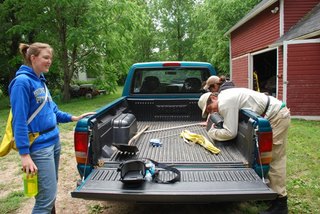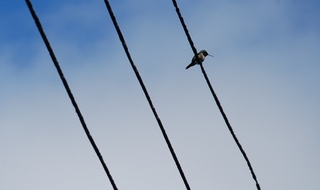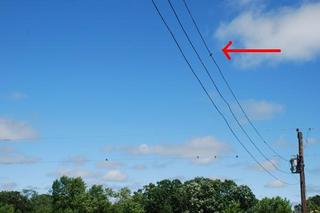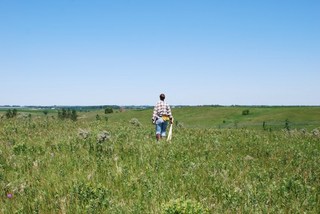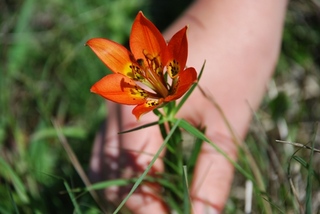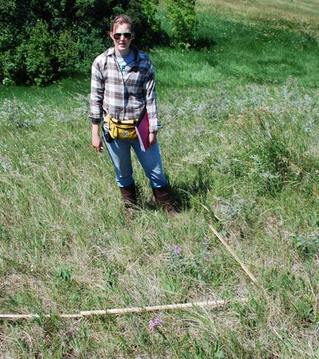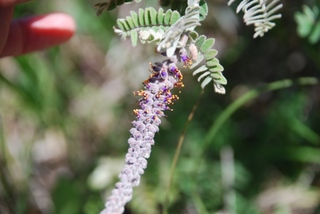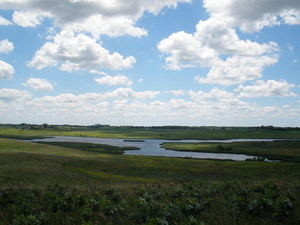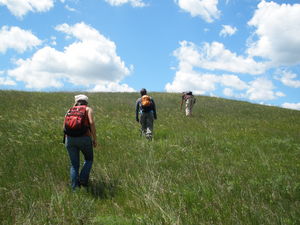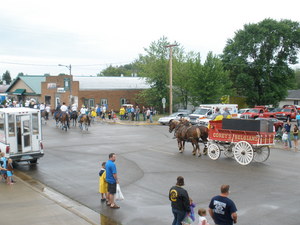|
|
As promised, you can read the protocol I’ve developed for collecting pollen styles from Echinacea plants. This protocol will be joined with Mimi and Amanda’s to form one complete and very awesome experiment. You can find my protocol here:
Kate’s Proposal_1.doc
Input welcome!
-Kate
Firstly, does anyone have a good acronym for this experiment? I tried PONS but don’t really like it.
Also, I wrote up a list of what each person needs for next week’s endeavors. If I’ve estimated times correctly, we need 9 people to do pollinator observations, 3-4 ppl for FNC (but the more the merrier), and 3-4 people for flagging plants beforehand (again the more the better) :ech PONS equip list.doc
What we still need :
>Ice packs (9)
>lunchbox coolers (6) I found 3 total but maybe there are more roaming around?
>stopwatch (1)–Greg offered to bring a couple back from his school for next week.Thanks Candyman!
9 possible remnants have been chosen (based on size of flowering plant populations in 2004 & 2005) and the back ups as well so here they are:
Staffanson, Landfill, North of Railroad crossing, LCW, NW Landfill, Riley, Yellow Orchid Hill, Steven’s approach, Nessman. Back ups: East Riley, EELR?, Railrd crossing
Hopefully Friday pm or Monday pm we can drive around to these sites and assess the abundance of flowering Echinacea plants, and also get a good understanding of what may be co-flowering with Echinacea next week. We will need to be flexible…if there aren’t enough plants flowering, then we will have to push the experiment back, and our second round later in the summer will have to be less than 2 weeks apart from the 1st round as we had originally planned.
A recent addition to our project is the potential to assess reproductive success using the style persistence method since it will be very valuable data and we are going to be collecting styles anyway for Kate.
We need to finalize protocols (I will try to post mine asap), figure out how to randomly select fl. plants in Staffanson and Landfill, the largest remnants, and I need to do some more practice runs of FNC with the newly made forms that Gretel helped me with today. We also will hopefully be able to do some practice runs of insect collecting this Friday with beemaster Amanda. I think field season is starting to get into full swing.
Thank you to everyone who has helped thus far with suggestions and advice. It has truly been appreciated.
Hey Everyone,
I’ve finally made it to the flog. So excited. ^_^
For all our loyal followers, my name is Kate and I’ll be starting the Masters program at Northwestern in the fall. Thus, part of my energy this summer will be devoted to thinking/researching/exploring possible masters projects. Stuart, Caroline, and Megan have already been very helpful in setting me on the right track; they all have some great ideas and thoughts on what I could focus on. I’m feeling a bit spoiled for choice, actually. Guess I have a lot of reading to do!
I will also be working with the Pollinator Sub-team of the Echinacea Team. Allegra, Amanda, Mimi and I will all be tackling various aspects of the great pollen issues surrounding Echinacea. The questions I will be attempting to shed light on include:
1) What pollen ends up on flowering Echinacea? In what quantities?
2) Is a plants floral neighborhood reflected by the pollen that ends up on the flower?
3) How does isolation impact the amount of pollen on Echinacea plants? How does the quantity/quality issue play out on isolated Echinacea vs. Bunched plants?
4) Does flowering early or late in the season have any impact on the amount of pollen a Echinacea receives?
I’ll be posting a proposal type document with my methods soon, so watch for that.
Ta for now,
Kate
I was recently informed that Daniel Rath has been “outblogging” me on the FLog, and I agree, he has– but it stops now. Daniel updates the FLog several times a week, and that’s cool. So from now on, every post Daniel posts, I too will post a post. Plus one.
Consider this a challenge, Daniel Rath!
To make up for lost time, and because if you’re anything like my mom (and you might be my mom– hi mom!) you love photos, here is a visual record of the past two days.
1) The past two mornings have been surprisingly cold here in K-town! Around 11:00 AM the truck bed has absorbed enough heat for a really fine cuddle.

2) On the way back from the ’99 South garden, Gretal (Queen Bee) and I saw a little hummingbird trying to run with the big dogs (some swallows) atop the telephone line.

3) In the end, he was a bit of an outcast.

4) Today many of us went to the landfill to practice our independent project techniques (characterizing floral neighborhoods, catching pollinators, collecting pollen from non-Echinacea flowers, etc). I expected a dump, but I found a wonderland– just see for yourselves!
Don’t be fooled, it’s not Italy- it’s a DUMP. In Kensington!!

Mimi couldn’t imagine what good deed could have landed her in such a place!

Then we found this Prairie Lily (Lilium Philidelphicum)

We got pulled over by this cop, and she made us characterize a floral neighborhood!

There was also some flowering Leadplant (Amorpha canescens)

I will post again soon about how my independent project plans are shaping up, so stay tuned. Don’t forget to leave feedback in the comments!!
Edit: Click on the photos if you’d like a slightly larger image.
In an attempt to outflog the rest of the team, I will describe what we did today. In the morning, most of us collected data for the phenology exp. No new plants had flowered, but some mistakes were caught in the flagging of positions from yesterday. I saw one of the large Halictid bees going to town on one of the flowering heads.Then until about 1, most of us headed out to the landfill site with different tasks in mind. I needed to do a test run of the FNC (I get tired of writing out floral neighborhood characterization) to see what obstacles we are going to face and about how long each one will take. Amanda helped me ID plants and test out the general protocol and it took about five minutes but there only 4 co-flowering species–Amorpha canascens, toothed evening primrose, Phlox pilosa, and Northern Bedstraw. Some species are more difficult to quantify in terms of number, such as Galium. After some discussion with Stuart, I think we will probably count each inflorescence as 1 “unit” so that counting the number of co-flowering species will be systematic and consistent. And now for more pretty pictures: 

Above: Glacial Lakes State Park trip, only a half hr away!

A plant we couldn’t ID. Help?


Old Runestone Day Parade pics, Per & Hattie the candy gatherers
Here’s a file that lists sites you can choose for your study.
Also, here’s a list of equipment that we used for during the first field season where we did systematic observations and collections of pollinators.
We have several microscopes and we would like to capture digital images of what we see–especially pollen grains. Which on should we pick? Any advice would be appreciated. Here are some links to pages about several models of inexpensive USB cameras that can mount to a microscope:
microsope.com sells several brand. They sell only one line from bigC.
Here’s a company that sells the EM series from bigC.
documentation pages on the bigC product line (more on the AM series than the EM series).
Another source of info on the Moticam line.
I scanned this list of companies that sell (and used to sell) microscope accessories to find the above links.
FYI I stumbled across some pollen identification keys: a taxonomic list, a key to pollen of the bahamas, and an inaccessible “pollen database” that sounds good.
Lots of plans for this week! Here are some highlights.
This week we will start systematic observations of Echinacea flowering phenology in the CG experiment. We want to know the first and last day of flowering for every head of every Echinacea plant in the CG. The main event early in the week will be to put a twist tie on every head that looks like it will flower. We will also put a flag near every flowering plant with its location on the flag. We have to get the locations (plant ids) correct and get it into a database. As of Sunday, four plants in the CG had started to flower, how many left to go? We will also record flowering phenology at Staffanson Prairie Preserve. We will observe many fewer plants, but it’s a long walk.
Under the supervision of DR, we will spend ~1h looking for more spittle masses on Ea in the CG.
Jennifer and Diedre are coming from IL this Sunday and will stay for the week. They will help set up the phenology flags. They also plan to collect tissue from plants in several remnants to do a population genetic study using microsatellites (DNA markers).
Daniel and Amy will make a plan for searching for aphids and juvenile plants in remnants.
Caroline will fill us in on her plans.
The competition of pollinators crew (M “floral neighborhoods” J, A “bee’s knees” G, K “style” G, A “the experimenter” H, and G “pollen from the source” D) will plan and practice for their project. Here are some things they will do…
Mimi: characterize floral neighborhoods
Amanda: catch bees, get pollen on slide
Kate: catch styles, get pollen on slide
Allegra: choose plants for experiment
Greg: order digital microscope cam & collect pollen (from the source)
GPS (maybe): Daniel & Amy.
What are we going to do about that tripod?
Here’s what I’ve come up with for the revisions to my original proposal as of Friday’s group discussion; it is not in full form yet but I wanted to flog what I have so far so that people could read it and correct any mistakes I’ve made, make suggestions, etc.
Thanks
jenkins echinacea proposal revised.doc
Oh and friday was a big day in the common garden because the first Echinacea plant (in the 99garden I believe) released its pollen. Tomorrow we will investigate to see if any more have followed suit. We also searched for spittle on Echinacea plants for an hour on friday to help Daniel know whether he has a sufficient sample size and found 22 with spittle on them in roughly half the garden.
And I like pretty pictures so here’s one for fun

-Mimi
Here’s my proposal for my project. Read it. Savor it. Constructively criticize it.
jenkins echinacea proposal.doc
It’s still very helter-skelter at this point and in need of much fine-tuning, so any suggestions are greatly appreciated. Thanks!
Also, I’ll re-attach the docx files from my last post in doc format.
Echinacea Pollinators nesting2.doc
Protocol for Taking Pictures of Insect Specimens.doc
On a side note, yesterday was a really exciting day because I found my first seedling, we got two bikes at a garage sale for $25 each, and there were the Runestone Days fireworks in the evening. The party lasted long into the night in K-town, and I think I remember falling asleep to the sweet sounds of AC/DC You shook me all night long coming from the street dance. These folks know how to party. I’m looking forward to the kiddie parade tomorrow! Although Amanda and I were saddened to hear it wouldn’t be a kitty parade.
|
|

